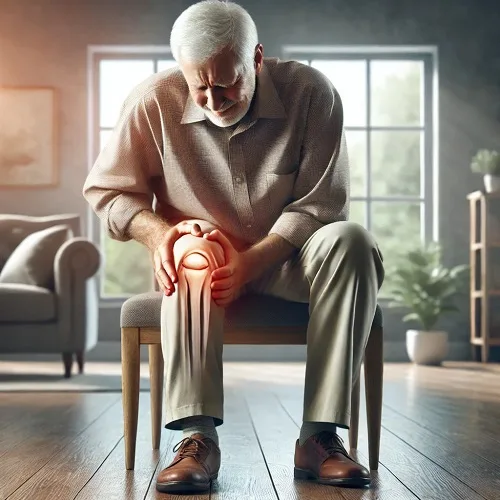Jump to Section
Introduction
Joint pain is a common problem that impacts millions of individuals globally. From older adults battling arthritis to athletes dealing with sports-related injuries, joint pain can significantly impact daily life. Whether it’s the discomfort of stiff knees, aching shoulders, or swollen wrists, joint pain can reduce mobility and diminish quality of life. While pharmaceutical medications can offer relief, they often come with unwanted side effects, dependency risks, or long-term complications.
This is where natural remedies for joint pain relief come in. These treatments offer a safer, more holistic approach, often with fewer side effects. More people are turning to natural options to alleviate pain, reduce inflammation, and promote joint health without relying on potentially harmful medications. In fact, some natural remedies have been shown to work just as effectively as prescription drugs, making them a compelling alternative for pain management.
In this article, we’ll explore a variety of natural treatments that have been proven to relieve joint pain. From anti-inflammatory herbs to simple lifestyle changes, you’ll discover practical solutions that can help you regain mobility, comfort, and an active lifestyle without depending on pharmaceutical painkillers. Whether you’re looking for long-term relief or a temporary fix, these remedies could be the answer you’ve been searching for.
Understanding Joint Pain and Its Causes

Joint pain refers to discomfort, swelling, or stiffness in any of the joints within the body. It can range from mild and temporary to severe and chronic, affecting the ability to move freely. The most common types of joint pain are osteoarthritis (OA), rheumatoid arthritis (RA), and gout. OA, typically associated with aging, occurs when the cartilage in the joint breaks down, leading to friction and pain. RA, an autoimmune condition, causes the body’s immune system to attack the joints, leading to inflammation, swelling, and pain. Gout, often linked to high uric acid levels, can cause sudden and intense joint pain, especially in the big toe.
The causes of joint pain vary widely. Common factors include injury, such as strains or sprains, aging, which naturally weakens joint cartilage, and overuse from repetitive activities. Inflammation is also a major contributor, often seen in conditions like arthritis. Additionally, underlying conditions such as rheumatoid arthritis, bursitis, and tendinitis can result in chronic joint pain and inflammation.
Managing joint pain is crucial because it can severely limit mobility, making even basic tasks difficult and diminishing overall quality of life. Left untreated, joint pain can lead to further deterioration, including reduced strength and flexibility.
The goal of natural remedies for joint pain relief is to address the root causes—like inflammation and lack of lubrication—without the side effects of synthetic drugs. These remedies help reduce swelling, improve joint function, and promote long-term health, offering a holistic and effective approach to pain management.
Why Choose Natural Remedies for Joint Pain Relief?

Choosing natural remedies for joint pain relief offers a range of benefits, making them an attractive option for many people. Unlike prescription medications, natural treatments are often holistic, meaning they aim to treat the body as a whole rather than just masking symptoms. This approach can help reduce pain and inflammation while promoting overall joint health. Moreover, natural remedies typically have fewer side effects compared to pharmaceutical drugs, which can sometimes lead to dependency or unwanted long-term health issues.
Another advantage of natural remedies is their ability to provide long-term relief. Many natural treatments not only address immediate pain but also help improve joint function over time by reducing inflammation, increasing mobility, and enhancing flexibility. By incorporating these remedies into your routine, you’re not just finding a quick fix—you’re working toward sustained health and well-being for your joints.
Natural remedies are also cost-effective and easily accessible. Unlike many medications, which can be expensive, especially over time, ingredients like turmeric, ginger, and Epsom salt are affordable and can be found in most homes or local stores. Additionally, these remedies often involve simple lifestyle changes, making them easy to incorporate into daily routines.
When we look at traditional remedies vs modern medicine, it’s clear that many natural treatments have stood the test of time. What’s even more promising is that modern science now supports many of these age-old remedies. Research has proven that several natural options, such as turmeric, ginger, and omega-3 fatty acids, can significantly reduce joint pain and inflammation, bridging the gap between ancient wisdom and modern medicine.
Top 7 Natural Remedies for Joint Pain Relief

When it comes to relieving joint pain, natural remedies offer effective, long-term solutions. Here are some of the most proven and accessible treatments, each backed by research for their efficacy.
1. Turmeric and Curcumin
- Benefits:
Turmeric is renowned for its powerful anti-inflammatory properties, making it one of the top natural remedies for joint pain relief. Curcumin, the active compound in turmeric, is known for its ability to reduce inflammation and relieve pain, particularly in conditions like osteoarthritis and rheumatoid arthritis. - How it works:
Curcumin works by blocking the production of inflammatory molecules, thus reducing swelling and discomfort in the joints. It also aids in the regeneration of damaged tissues, promoting overall joint health. - Scientific backing:
Numerous studies have supported the efficacy of curcumin in managing joint pain. A study published in the Journal of Medicinal Food found that curcumin was as effective as ibuprofen in reducing pain and inflammation in osteoarthritis patients. - Usage tips:
To incorporate turmeric into your daily diet, try adding it to curries, soups, or smoothies. You can also brew turmeric tea or take curcumin supplements for more concentrated benefits. For better absorption, pair turmeric with black pepper.
2. Ginger
- Benefits:
Ginger is another powerful natural remedy for joint pain due to its anti-inflammatory and analgesic properties. It has been used for centuries to alleviate muscle pain and joint stiffness. - How it works:
Ginger contains gingerol, a compound known to inhibit inflammatory pathways, which helps reduce both pain and swelling in the joints. It also improves blood circulation, aiding in the delivery of nutrients to the affected areas. - Scientific backing:
Research has shown that ginger extract can significantly reduce pain and improve joint mobility in patients with osteoarthritis. A study in Osteoarthritis and Cartilage concluded that ginger supplementation reduced joint pain and improved mobility. - Usage tips:
You can consume ginger fresh, dried, or as a tea. Simply grate fresh ginger into boiling water for a soothing tea, or add it to your meals. Ginger supplements are also available for targeted relief.
3. Epsom Salt Baths
- Benefits:
Epsom salt baths are a popular remedy for muscle relaxation and joint pain relief. The magnesium in Epsom salts is known to help soothe sore muscles and reduce inflammation. - How it works:
When absorbed through the skin, magnesium helps relax muscles, reduce swelling, and improve joint function. It also promotes better blood flow, which can aid in the healing process of damaged tissues. - Scientific backing:
While more research is needed, studies have shown that magnesium can help manage muscle and joint pain. A review published in The Journal of Clinical Psychology highlighted magnesium’s role in reducing chronic pain and inflammation. - Usage tips:
To use Epsom salts, simply dissolve 1-2 cups in a warm bath and soak for 15-20 minutes. This can help ease pain and tension in both muscles and joints.
4. Omega-3 Fatty Acids
- Benefits:
Omega-3 fatty acids are essential fats that have powerful anti-inflammatory effects. They can significantly reduce joint pain and improve flexibility in people with inflammatory joint conditions like arthritis. - How it works:
Omega-3s, particularly EPA and DHA, reduce the production of inflammatory molecules and help protect joints from further damage. They also support the lubrication of joints, easing stiffness and discomfort. - Scientific backing:
Studies have repeatedly shown the effectiveness of omega-3s in managing joint pain. A study in the American Journal of Clinical Nutrition found that omega-3 supplements reduced symptoms of rheumatoid arthritis and improved joint function. - Usage tips:
The best sources of omega-3 fatty acids include fatty fish like salmon, sardines, and mackerel. You can also get omega-3s from plant-based sources like flaxseeds, chia seeds, and walnuts. Omega-3 supplements are widely available for those who prefer a concentrated dose.
ALSO READ
Sexual Benefits of Black Ginger for Men: Boost Performance
Foot and Lower Leg Massage: 15 Incredible Benefits
Unlock the 15 Powerful Benefits of a Foot Arch Massage
Unlock the Sexual Benefits of Ginger and Garlic Mixture
Intuition vs Anxiety: Uncover the Truth Behind Your Feelings
5. Heat and Cold Therapy
- Benefits:
Heat and cold therapy offer immediate relief for joint pain by reducing swelling and easing muscle tension. Alternating between the two can help manage symptoms more effectively. - How it works:
Heat therapy increases blood flow to the affected area, relaxing muscles and soothing stiffness. Cold therapy, on the other hand, numbs the area and reduces inflammation, providing quick relief from pain. - Scientific backing:
Research supports the use of heat and cold therapy for joint pain relief. A study published in Clinical Rheumatology found that alternating heat and cold can reduce pain and swelling in arthritis patients. - Usage tips:
For heat therapy, use a warm towel or heating pad on the affected joint for 15-20 minutes. For cold therapy, apply an ice pack wrapped in a cloth to the joint for the same amount of time. Be sure to not apply ice or heat directly to the skin to avoid injury.
6. Exercise and Physical Therapy
- Benefits:
Regular exercise and physical therapy can help strengthen the muscles surrounding the joints, improving stability and reducing pain. Movement also enhances blood circulation and joint lubrication. - How it works:
Exercise improves joint flexibility, increases muscle strength, and promotes better circulation, which can alleviate joint pain. Low-impact exercises, such as swimming, cycling, or walking, are particularly beneficial for people with joint issues. - Scientific backing:
Several studies have confirmed that exercise can reduce joint pain and improve function. A clinical trial published in Annals of Internal Medicine found that physical therapy significantly reduced pain and improved joint mobility in patients with knee osteoarthritis. - Usage tips:
If you’re new to exercise, start with low-impact activities like walking or swimming. Physical therapy exercises focusing on strengthening muscles around the joint can also be very effective in managing pain. Always consult a healthcare provider before starting a new exercise regimen.
7. Topical Treatments: CBD Oil and Arnica
- Benefits:
CBD oil and Arnica are two effective topical treatments for joint pain. CBD oil has natural anti-inflammatory and pain-relieving properties, while Arnica is known for promoting healing and reducing bruising and swelling. - How it works:
CBD oil interacts with the body’s endocannabinoid system to reduce pain and inflammation. Arnica contains compounds that help decrease swelling and encourage faster tissue healing, making it ideal for joint-related injuries and inflammation. - Scientific backing:
Research supports both CBD oil and Arnica for joint pain relief. A study in Frontiers in Pharmacology found that CBD oil significantly reduced pain and inflammation in individuals with arthritis. Similarly, studies have shown that Arnica can effectively reduce pain and swelling in people with osteoarthritis. - Usage tips:
For CBD oil, apply a few drops directly to the affected joint and massage gently. For Arnica cream, apply it directly to the painful area a few times a day. Both treatments can be used as part of a daily joint care routine.
These natural remedies for joint pain relief offer effective, long-lasting solutions without the risks associated with pharmaceuticals. Incorporating these remedies into your daily routine can help reduce pain, increase mobility, and improve your quality of life.
Lifestyle Changes for Joint Pain Prevention

In addition to natural remedies for joint pain relief, adopting certain lifestyle changes can significantly help in preventing or managing joint pain over the long term. Here are key aspects to focus on:
Diet: Importance of an Anti-Inflammatory Diet
A healthy diet plays a crucial role in joint health. Anti-inflammatory foods can help reduce joint pain and prevent further damage. Focus on incorporating omega-3-rich foods (like salmon, walnuts, and flaxseeds), fruits and vegetables (especially leafy greens, berries, and citrus), and whole grains. Avoid processed foods, sugars, and excessive fats, which can contribute to inflammation and worsen joint pain. Eating a balanced diet that supports your body’s natural healing process is essential for managing joint health.
Weight Management: Reducing Stress on Joints
Maintaining a healthy weight is vital for joint pain prevention. Excess body weight places added pressure on weight-bearing joints like the knees, hips, and lower back, accelerating wear and tear on cartilage and increasing inflammation. By losing even a small amount of weight, you can reduce the stress on these joints, thus minimizing pain and improving mobility. A balanced diet, coupled with regular exercise, is an effective strategy to maintain a healthy weight and support joint function.
Posture and Movement: How Proper Posture and Movement Prevent Joint Pain
Maintaining proper posture and body mechanics during daily activities can help prevent joint strain. Whether sitting, standing, or lifting, good posture ensures that your joints are aligned properly, reducing unnecessary stress. Regular movement is also essential. Avoid prolonged periods of sitting or standing; instead, engage in gentle stretches or walks throughout the day to keep your joints flexible and functioning optimally.
Supplements: Highlight Key Supplements that Support Joint Health
Certain supplements can provide additional support for joint health. Glucosamine and chondroitin are popular supplements known for their ability to support cartilage health and improve joint function. Vitamin D is also important for bone health, while MSM (Methylsulfonylmethane) helps reduce inflammation and supports the flexibility of joints. Before starting any supplement regimen, it’s important to consult a healthcare provider to ensure it aligns with your specific health needs.
Incorporating these lifestyle changes, alongside natural remedies, can provide long-term benefits for joint health, helping you maintain an active and pain-free lifestyle.
FAQs on Natural Remedies for Joint Pain Relief
Here are 12 frequently asked questions regarding natural remedies for joint pain relief to help guide you in your journey toward pain-free living.
What is the best natural remedy for joint pain?
The best natural remedy for joint pain often depends on your specific needs, but turmeric and ginger are two of the most popular and effective options. Both have strong anti-inflammatory properties that help reduce swelling and discomfort. Regular use, either in food or supplements, can provide long-term relief.
Are natural remedies effective for chronic joint pain?
Yes, natural remedies can be quite effective for managing chronic joint pain. They work by addressing the root causes like inflammation and stiffness over time. Remedies like omega-3 fatty acids, exercise, and heat/cold therapy are particularly beneficial for long-term management, helping to reduce pain and improve mobility gradually.
How long does it take for natural remedies to show results?
Natural remedies usually take longer to show visible results compared to conventional medications. Depending on the remedy, you may begin to feel some relief within a few days to a week, but full benefits can often take several weeks. Consistency is key when using natural remedies for joint pain.
Can natural remedies replace prescription medications?
Natural remedies can complement prescription medications but may not fully replace them, especially in severe cases of joint pain or inflammation. Consult your doctor before discontinuing any prescribed medication. In many cases, natural remedies can work synergistically with medications to reduce dependency on painkillers.
Are there any side effects of natural joint pain remedies?
While natural remedies generally have fewer side effects than pharmaceutical drugs, they are not completely risk-free. Some people may experience mild digestive discomfort from herbs like turmeric or ginger. It’s important to consult with a healthcare provider before starting any new treatment, especially if you are pregnant, nursing, or on medications.
Can exercise worsen joint pain?
Exercise, when done correctly, can actually help alleviate joint pain by strengthening the muscles around the joints, improving flexibility, and enhancing circulation. However, high-impact exercises or overexertion can worsen joint pain, so it’s best to stick to low-impact activities like swimming or cycling. Always consult a physical therapist for the best exercises tailored to your needs.
Is CBD oil effective for joint pain relief?
CBD oil has shown promise as a natural remedy for joint pain relief, particularly in managing inflammation and discomfort. A number of studies support its efficacy for conditions like arthritis. However, its effects can vary from person to person, so it’s important to experiment with dosages and consult a healthcare provider for personalized guidance.
How can a diet impact joint pain?
An anti-inflammatory diet can significantly reduce joint pain. Foods like omega-3-rich fish, leafy greens, and berries help decrease inflammation, while processed foods, sugars, and trans fats can increase joint pain and inflammation. Eating a balanced diet supports overall joint health and can prevent further pain.
What lifestyle changes can prevent joint pain from worsening?
Maintaining a healthy weight, staying active with low-impact exercises, improving posture, and eating an anti-inflammatory diet are all lifestyle changes that can help prevent joint pain from worsening. Regular stretching, proper ergonomics at work, and using joint-supportive devices can also be helpful.
Can magnesium supplements help with joint pain?
Yes, magnesium can play a role in relieving joint pain by reducing muscle spasms, inflammation, and stiffness. It’s known for its ability to relax muscles and improve circulation. Magnesium supplements, as well as Epsom salt baths, can be useful for joint pain relief, especially when combined with other natural remedies.
Are there any risks with using essential oils for joint pain?
Essential oils like peppermint and lavender have anti-inflammatory properties and can offer temporary joint pain relief. However, it’s important to dilute them properly before use to avoid skin irritation or other adverse reactions. Always test a small amount on your skin first and consult a healthcare provider if you’re unsure about the safety of essential oils for your condition.
Can joint pain relief supplements work as effectively as prescription medications?
While joint health supplements like glucosamine, chondroitin, and MSM may help relieve mild to moderate joint pain, they may not be as effective as prescription medications in severe cases. These supplements work best when used as part of a holistic approach, including exercise, proper diet, and other natural remedies. Always consult a doctor to determine the best course of treatment for your specific condition.
These FAQs address some of the most common concerns about natural remedies for joint pain relief. Each remedy has its strengths and limitations, so finding the right combination for your needs is essential. Always consult with a healthcare provider for personalized advice tailored to your condition.
Conclusion
Natural remedies for joint pain relief offer an accessible and effective alternative to traditional medications. With benefits like fewer side effects and a holistic approach, they can provide long-term relief by addressing the root causes of pain, such as inflammation and stiffness. Remedies like turmeric, ginger, omega-3 fatty acids, and simple lifestyle changes, including diet and exercise, are proven to help manage joint pain and improve overall mobility.
It’s essential to approach joint pain management proactively. By consistently applying natural remedies and adopting healthier lifestyle habits, you can enjoy lasting relief and better quality of life. Whether you’re seeking to reduce inflammation, improve joint function, or simply ease discomfort, natural solutions are a powerful tool.
Remember, while natural remedies are effective, consulting with a healthcare provider is crucial to ensure that the chosen treatments align with your individual needs. Try incorporating these remedies into your routine today and take control of your joint health for a more active and pain-free tomorrow.
References
- Curcumin: A Natural Anti-Inflammatory Compound
Aggarwal, B. B., & Harikumar, K. B. (2009). Curcumin: the Indian solid gold. Advances in Experimental Medicine and Biology.
Read the study - Exercise and Joint Health
Mayo Clinic – Exercise helps ease arthritis pain and stiffness
Learn more - Arnica for Osteoarthritis Pain
Widrig, R., et al. (2007). Sore joints? Arnica shows promise for osteoarthritis. Rheumatology International.
Read the study - Weight Management and Joint Health
Harvard Health Publishing – How excess weight affects your joints
See article






